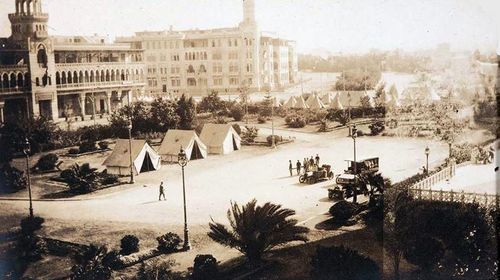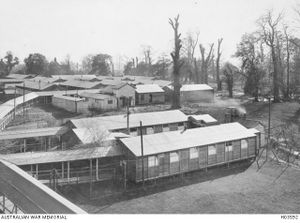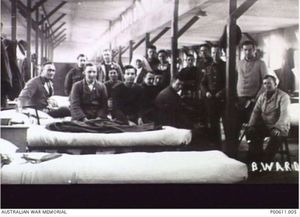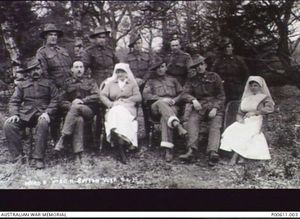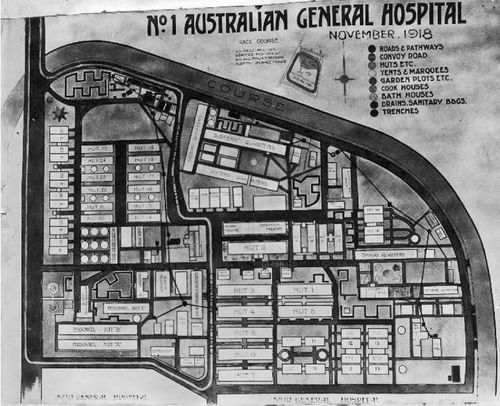1st Australian General Hospital
From Our Contribution
General Information
Authority to be raised was granted in Aug 1914, and while the Medical Officers and Nurses came from all states, the enlisted men were recruited at Bowen Park camp in Brisbane. At the time of departure from Brisbane on 21 Nov 1914 for Egypt it was structured to care for 520 beds. Aboard HMAT A55 Kyarra it was part of the first convoy from Albany to Alexandria. Also aboard was the 2nd Australian General Hospital; Nos 1 & 2 Australian Stationary Hospitals, and the 1st Australian Casualty Clearing Station.
On arrival in Egypt on 14 Jan 1915 it was established in a large building and tents at Heliopolis a suburb of Cairo, before opening for patients 10 days later. The patients received consisted of all ranks of the A.I.F., and all classes of cases were treated, physical injuries, diseases and shell shock.
After a short period, and owing to circumstances, the hospital took over other additional premises for the treatment of different classes of cases. Other buildings in Heliopolis such as the Aerodrome, The Luna Park, The Atelier; The Sporting Club, and the Artillery Barracks at Abbasia Depot. Later these separate locations were given their own personnel and equipment and became Numbers 1- 4 Australian Auxiliary Hospitals, with Abbasia being an annex to the main hospital.
During the Gallipoli campaign, and in the time before the majority of the troops redeployed to France, it catered for all war causes - physical injury, diseases, and shell shock, requiring it to be expanded to care for 750 beds. Over a period of 15 months the hospital cared for many thousands of sick and wounded Australian servicemen. In March 1916 the hospital was ordered to close and to follow 1 ANZAC Corps and the 2nd Division to France.
For the shift to France, the hospital was packed up and its patients transferred to the Auxiliary Hospitals, before boarding HMHS Salta. Departing for France from Alexandria on 29 Mar 1916, it was structured for 750 beds, with a Nursing staff of 117. Later during 1916, in France it was enlarged to 1040 beds.
On arrival in Marseilles on 5 Apr 1916 they had to wait several days for orders before proceeding by rail to Rouen, arriving on 13 Apr 1916. Initial size of the hospital in Rouen only required 75 nurses so the balance of 42 were detached to British units. The hospital opened for patients on 29 Apr 1916 and was structured to cater for general battle casualties. Patients came from all British and British empire nations, but only enlisted men as Officers were treated elsewhere.
At the conclusion of hostilities, the hospital ceased to accept new patients from 30 Nov 1918 ahead of its closure on 7 Dec 1918 and its relocation to Sutton Veny in England. At Sutton Veny a hutted hospital had opened in 1916, providing beds for 11 Officers and 1,261 soldiers, and it was to this hospital that staff of 1AGH returned in January 1919. At this time most patients were suffering with the Spanish influenza epidemic, and this was the cause of death for many of the 143 Australians buried in St John's churchyard.
Staff
- Alice Maud Martin 18 Jul 1915 to 1 Feb 1918 (Heliopolis Egypt & Rouen France)
- Euphemia Weir Huntley Scott 6 Apr 1916 to Apr 1918 (Rouen France)
Individual Honours
- 1 Distinguished Service Order
- 3 Royal Red Cross (2nd Class)
- 1 Military Medal
- 1 Meritorious Service Medal
- 7 Mention in Despatches
Soldier Patients by date admitted
Heliopolis, Egypt
1915
- John Alexander Spilsbury 30 Apr - 14 Jun 1915
- † Elmer Winfred Drake Laing MC 3 May 1915 - ??
- Samuel Edward Tate 7 Jun - 20 Jul 1915
- Bernard O'Reilly 7 Jun - 4 Jul 1915 Post WW1
- Charles Gorringe 20 - 27 Jun 1915
- Reginald Alfred Nicholas MBE 22 Jun - 6 Aug 1915
- Frederick Thorneycroft Plant 30 Jun - 16 Jul 1915
- Patrick O'Connell McKenna 27 - 29 Jul 1915
- Fritz Robert Jaentsch 31 Jul - 13 Aug 1915
- † Edward (Ted) Harry Darby 8 Aug 1915
- William Henry Shade 10 - 14 Aug 1915
- Thomas Edward Raine 11 Aug 1915
- Albert Stephenson Jackson 10 Aug - 1 Oct 1915
- Frederick William Scott 13 - 14 Aug 1915
- Harold V Marshall 16 Aug - 12 Sep 1915
- Ronald Adolphous Julian Batt 21 - 24 Aug 1915
- Ernest Wright Holroyd 25 Aug 1915
- John Charles Hutchinson 25 Aug - 7 Sep 1915
- Hugh Henry Smith 21 Sep - 3 Nov 1915
- Vernon Claude Witney 14 Oct 1915 - ??
- Samuel Edward Tate 18 Oct - 13 Nov 1915 (second time)
1916
- Edward James (Ted) Rouse 6 - 14 Mar 1916
Rouen, France
1916
- Thomas Herbert Ludlow 23 May - 7 Jun 1916
- † Herbert Frank O'Neill 26 - 29 Jul 1916
- Frank Halliday 1 - 4 Sep 1916
- John Donaldson Patterson 12 - 14 Nov 1916
- Roby Helliwell 15 - 20 Nov 1916
1917
- James Willie Bush 17 - 21 Jan 1917
- Hector Lionel Saw 16 - 27 Apr 1917
- William Thomas Saw 16 - 27 Apr 1917
- Thomas McGow 11 - 13 Jun 1917
- William Henry Baldwin October 1917 & 6 Apr to 8 Jun 1918
- David Forbes Abernethy October 1917
1918
- John Alexander Adamson 20 Mar - 4 Apr 1918
- William Henry Baldwin 6 Apr - 8 Jun 1918
- Thomas Herbert Ludlow 3 - 9 Jun 1918
- Harry Simpson Francis 6 - 26 Jul 1918
- John Kiely 29 - 31 Aug 1918
- Ernest William George Reed 19 - 21 Sep 1918
- Thomas Edward Tyrell Marshall 20 - 29 Sep 1918
- Frederick John Chester 4 Oct 1918
- George Henry Holroyd 4 Oct 1918
- George Thomson 7 - 8 Oct 1918
- William Robert Rigby 13 - 29 Dec 1916]] 16 - 18 Oct 1918
- George Wistlecraft 16 - 30 Oct 1918
- Arthur Leworthy Bettenay ?? 1918 - 4 Jan 1919
Sutton Veny, England
1919
- Ernest Albert Batt 24 Jan - 18 Feb 1919
- Harold Empsall 10 Jun - 3 Jul 1919
- John Thomas Clements 16 - 30 Jul 1919

